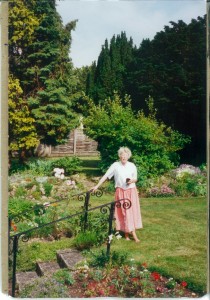
It didn’t hit me at first.
I was just relieved that the letter had arrived from my sister in England, ten days overdue, with my Canadian publisher starting to send email inquiries that were getting more frequent and less elaborately polite.
I ripped the envelope open and yes, there it was, between two sheets of cardboard: the photo my publisher wanted to put on the cover of the now-imminent Canadian edition of Signs of Life, my book about hospice. The last photo taken of my mother before she died.
No time to lose. I ran over to Kinko’s had them scan the photo and put it on my USD drive, ran back home, plugged in the drive, dragged the file to my desktop, and opened it up.
Even then it didn’t hit me—and it says something strange about computers, or about human beings, or about language, that it only hit me when I realized I had to give the file a name, and typed “Farewell.jpg.” That was when I knew at once that the rest of the day was lost. A wreck. Just that word “farewell.”
In the photo, she’s standing in the garden outside her flat in Bath, in England, where she spent her final years, the garden she planted and tended and was perhaps her final gesture of self-expression.
Age has mellowed her in all kinds of ways: she is wearing a loose white blouse and a dusty rose-colored peasant skirt, and she stands barefoot on the lawn, one hand on the railing of the four stone steps that lead down to the broad windows of her flat, and you’d never be able to tell whether she’s leaning casually or whether she needs that support now the cancer has robbed her of most of her extraordinary strength. In the other hand she’s holding a stoneware goblet, almost certainly containing cider, in a gesture that, in the Roman fashion, might mean hail or farewell.
Fifteen years telescoped into nothing, and it struck me, once and for all, that the only thing that never dies is loss.
I found a copy of the original U.S. edition of Signs of Life to see it still held true, what I had written all those years ago.
“Grief is a kind of message, and the importance and urgency of that message can be gauged by the power with which it hits us. What else can affect us as strongly as the death of a parent, or a child, or a spouse? Yet rather than believing that we’ve caught a glimpse of how much other people mean to us, and how powerful and lasting and redemptive this emotional or spiritual dimension of life is, we interpret our turbulence as pathology, the cure for which is to dismiss what we have just seen and to return to living among things that cannot affect us….”
Yeah, I’d say that still holds true.
“This awful back-to-reality period…was about recognizing truth. The bereaved are said to have difficulty coping with grief, and the remedy is said to be that we should get back into a routine as soon as possible, as if we had fallen off a horse. To me, the reverse was true: the … months after Mum’s death had shown me how shallow, mechanical, and unsatisfying the routine world was, and during this vulnerable time the last thing I wanted to do was to go back there.”
The freezer in the middle of being defrosted, the courses to be prepped for the beginning of the semester on Monday, even the simple act of conversation—they existed now in a different world, a world behind glass.
“It was as if I had flowed like water out of a culvert into the sea, teeming with life and possibility, and [to go back to my ordinary life was like being] forced to run the film backwards, to leap back up and compress myself into that narrow, dark pipe.”
Tim Brookes, Inc.
Adventures in Writing
10
Jan
Tim Brookes
- Editing and Publishing Services
- Vermont Wedding Music
- Writers Without Borders
- Bio/Contact
- Books
- A Hell of a Place to Lose a Cow
- A Warning Shot
- Catching My Breath
- Endangered Alphabets
- First Time Author
- Guitar: An American Life
- SARS: Behind the Mask
- Signs Of Life
- The Driveway Diaries
- The End of Polio?
- The Ghosts of Good Intentions
- The Short, Sweet Guide to Dialogue
- The Story So Far
- Thirty Percent Chance of Enlightenment
- Adventures in Writing
Other Sites of Interest
Subscriber Count
83
Subscribe!
Recent Entries
- Endangered Alphabets….sudoku?
- Endangered Alphabets: the next exhibition takes shape!
- Pre-Christmas Carving Sale
- Last chance to buy several of my favorite books!
- Here we go! The last 24 hours!
- Now or Never: the Atlas of Endangered Alphabets
- Halfway through the thousand-dollar weekend, halfway to our milestone!
- A third of the way there!
- Kickstarter Launch: The Atlas of Endangered Alphabets!
- The Gift Every Graduate Needs
Recent Comments
- Ron Shaw in Guitar: An American Life
- admin in Guitar: An American Life
- Joe Fitzpatrick in Guitar: An American Life
- Ginger in Coming soon: a reading from my newly-completed nov…
- admin in 'Tis the Wedding Planning Season
- asad in 'Tis the Wedding Planning Season
- admin in Yes, But What Does It Look Like?
- Contreras in Yes, But What Does It Look Like?
- Rose in Now out: First Time Author!
- admin in A Day in the (Productive) Life

Related Articles
No user responded in this post
Leave A Reply